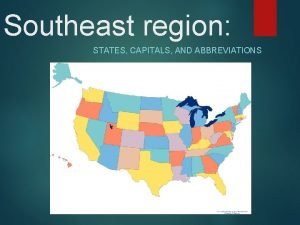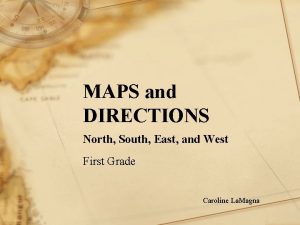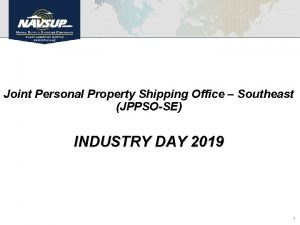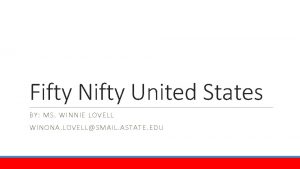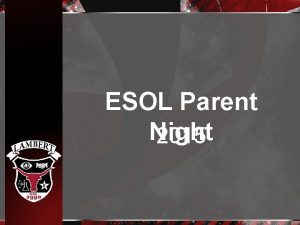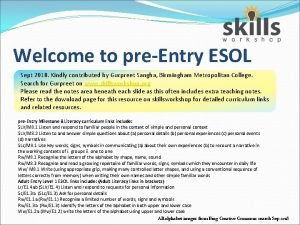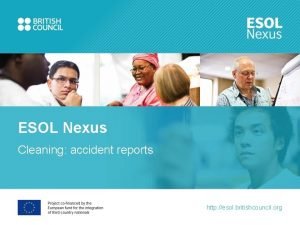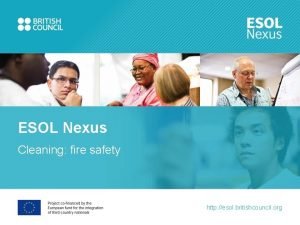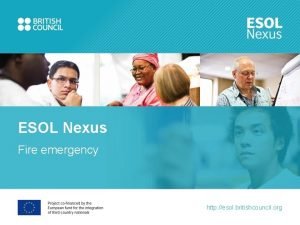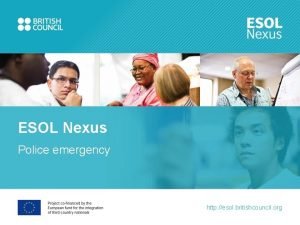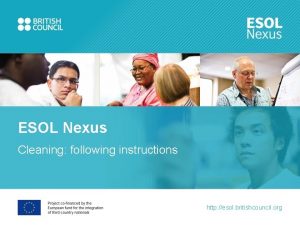Preentry ESOL A Guide for the South East










- Slides: 10

Pre-entry ESOL: A Guide for the South East Region October 2018

THE CONTENT OF THE GUIDE • To provide information and guidance about pre-entry level ESOL provision for resettlement coordinators and others involved in the refugee resettlement process • To be used alongside other SESPM support, information and resources: • ‘How to guide’ on delivering ESOL • help-desk to provide information on ESOL and offer support with commissioning of new ESOL provision • map of ESOL provision in the South East

KEY POINTS FOR PRE-ENTRY LEVEL PROVISION - VPRS • Many refugees resettled through the Syrian Vulnerable Persons Resettlement Scheme arrive with very low levels of English and often lack or have poor literacy in their first language. • The existing ESOL provision in your area may not be appropriate for those learners. • Local authorities are required to assess the language needs of resettled refugees at the earliest opportunity; for those assessed as being at pre-entry level 1 ESOL, formal provision may not be available or suitable. In those instances, informal language learning may be more appropriate.

KEY POINTS – DEFINITION Guidance on Commissioning ESOL for those on the VPRS gives the following definition for pre-entry level provision: ‘Complete beginners. Doesn’t understand very much; may be able to answer questions for basic personal information and follow basic instructions’

KEY POINTS – INITIAL ASSESSMENT • The initial assessment for those who have very little English is particularly important. Engaging interpreters and other support people is essential to assist this process. Individual assessments are often more effective at this level. • It is important to identify learners with low levels of literacy early in the assessment process, as learners may otherwise become stressed anxious. The provider of the initial assessment and any related advice should act as an ‘honest broker’ and refer to the most suitable provider.

KEY POINTS – FUNDING 1/2 • Government funding for ESOL is provided by the Education and Skills Funding Agency (ESFA), Adult Education Budget (AEB) for people over the age of 19 for courses delivered in further education colleges and community education settings and can be used for preentry level provision. • ‘Local flexibility’ for AEB funding allows colleges and training organisations to deliver locally devised nonregulated learning that can include pre-entry level ESOL to respond to local skills and community needs

KEY POINTS – FUNDING 2/2 • ESOL up to and including Level 2 is fully funded for eligible learners age 19 and over who are unemployed and in receipt of JSA, ESA or universal credit • Learners who are employed and/or not in receipt of certain benefits are co-funded • For 2018/19, providers can fully-fund learners who are in employment and in receipt of a low wage, who cannot contribute to the co-funded element • Providers can receive extra funding support for learners who progress slowly and need more hours in order to achieve a ‘regulated’ or ‘non-regulated’ qualification or learning aim. This can support the inclusion of learners with some pre-entry level ESOL needs

KEY POINTS – PRE-ENTRY ESOL LEARNERS • Some learners may have little ‘English awareness’ i. e. there is little about English that they know already • Learners often want to focus on the kinds of language skills that they need for immediate use in their everyday lives • With new learners, and particularly those who do not have prior experience of schooling, it is important to base the language learning on aspects where learners can gain a sense of progress as quickly as possible

FINAL KEY POINTS • It is helpful if learners can access pre-entry provision with providers that offer progression opportunities as this can be a motivating factor • Most pre-entry learning is likely to be non-accredited i. e. learning which does not lead to a qualification • Challenges are similar to those experienced when working with learners at higher ESOL levels, such as practical and cultural barriers, course content and progression, though they may be more difficult to address • Resources – learning, teaching and professional development

OVER TO YOU • An opportunity to look through the guide • Consider how the information can be useful to address some of the challenges • Share your thoughts/comments Link to the guide: http: //www. secouncils. gov. uk/wp-content/uploads/2012/04/Pre-entry-ESOLguide-FINAL. pdf
 West north west wind direction
West north west wind direction Near east vs middle east
Near east vs middle east East is east and west is west
East is east and west is west Southeast states capitals and abbreviations
Southeast states capitals and abbreviations Orthopaedic services east london
Orthopaedic services east london World map north south east west
World map north south east west The meeting of longitude and latitude lines
The meeting of longitude and latitude lines Jppso southeast
Jppso southeast Fifty nifty united states from thirteen original colonies
Fifty nifty united states from thirteen original colonies North south east west in our calm objective opinion
North south east west in our calm objective opinion The southeast asian ministers of education organization
The southeast asian ministers of education organization



